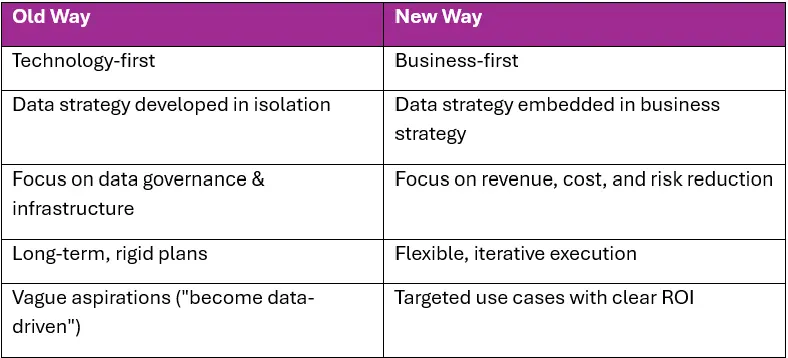
Strategy Isn’t What I Thought It Was and Many Still Get It Wrong
Back in 2002, I was thrown in at the deep end, tasked with creating a data strategy for a global business I worked for. At the time, I thought “strategy” was just a sophisticated way of saying “plan.” I believed it was about mapping things out in a structured way, like a detailed blueprint.
I quickly realized I was wrong.
I didn’t realise then that real strategy isn’t just about planning, it’s about making choices. It’s about making trade-offs, aligning with business goals, and ensuring execution delivers measurable impact.
It took hard lessons, missteps, and seeing the impact of bad strategy (or no strategy at all) to really understand what makes a data strategy effective.
At the time, I learned this through trial and error, oh and a lot of mentoring from my CEO.
But even today, over two decades later, I see many organizations still making the same fundamental mistakes.
A Familiar Data Issue
Many organizations today have a data strategy, but if you ask senior leadership how it contributes to business outcomes, you’ll often get vague or inconsistent answers.
The issue? Most data strategies fail to drive impact because they:
- Are overly focused on technology rather than business priorities.
- Lack clear alignment with revenue, cost savings, or risk mitigation.
- Are disconnected from decision-making at the executive level.
- Take too long to show tangible results, leading to loss of buy-in.
Recognizing the Symptoms
You may be facing this problem if:
- Your data strategy is seen as an IT initiative rather than a business enabler.
- Data “projects” struggle to secure investment because their value is unclear.
- Business leaders are frustrated with slow or no progress on data initiatives.
- Teams collect and store vast amounts of data but don’t translate it into real insights.
- AI and analytics investments haven’t delivered the expected ROI (yet)!
If any of this sounds familiar, you’re not alone, these are common failure points in data strategy execution.
Why This Keeps Happening
These failures don’t happen in isolation; they stem from recurring mistakes:
- Strategy is confused with planning. Many leaders assume that creating a strategy means laying out a multi-year roadmap. But a roadmap without clear decision-making principles isn’t a strategy it’s just a plan.
- Technology leads the conversation. Organisations invest in platforms and tools before defining the business problems they need to solve. This results in expensive solutions searching for a use case.
- Data remains siloed from the business. If data leaders operate separately from business strategy discussions, the connection between data and value is lost.
- ROI is not front and center (how many times have I said that!) Data teams focus on delivery rather than impact, measuring outputs (dashboards, reports, models) rather than business outcomes (cost savings, revenue growth, efficiency gains).
The Shift That Changes Everything
Is this the “AHA” moment? Maybe! The actual breakthrough moment comes when organizations stop treating data strategy as an internal technical exercise and instead see it for what it is: a business strategy that uses data as a lever for growth and efficiency. That’s why I’ve always wished it was just called good old business strategy and that everything else was incorporated into it!
Does it matter? Of course, it does and the shift in mindset and behaviors looks like this:

This shift is where real transformation happens.
How We Make It Work
At datazuum, we’ve seen the impact of both ineffective and effective data strategies. Here’s how we ensure success:
- Start with a business problem. Instead of asking, “What’s our data strategy?” we ask, “What business problem are we solving?” Whether it’s customer churn, operational inefficiencies, or revenue leakage, defining the right problem is step one.
- Identify high-impact use cases. Not all data initiatives are equally valuable. We prioritize use cases that have a direct, measurable impact on revenue, cost, or risk reduction.
- Design the operating model. A strategy only works if the right people, processes, and governance are in place to execute it. We establish clear roles, responsibilities, and ways of working, “making the strategy real”.
- Prove value quickly. Instead of waiting months for results, we focus on delivering quick wins within weeks, whether it’s an insight that saves money or a pilot that unlocks new revenue.
- Scale and optimize. Once we prove impact, we scale successful initiatives across the organization while refining processes for long-term sustainability.
What Happens When You Get It Right
To illustrate this approach, here are two examples of organizations that pivoted to a business-first data strategy and saw tangible results:
- Retail: Reducing Stockouts and Overstocks
- A global retailer struggled with inventory management, leading to lost sales due to stockouts and excess costs due to overstock. Initially, their data strategy focused on centralizing their data into a warehouse, a costly, multi-year initiative with no immediate ROI.
The shift: By identifying key business use cases, starting with demand forecasting for high-value products. Using existing data more effectively, they saw a 12 percent reduction in stockouts and a 15 percent reduction in inventory holding costs within six months.
- Financial Services: Increasing Customer Retention
- A bank was losing customers but lacked insight into why. Their initial approach was to build a “360-degree customer view,” an expensive project with no clear business value.
The shift: Focusing on high-value customer segments and identified leading indicators of churn. By deploying targeted interventions (e.g., personalized offers and proactive engagement), the bank reduced churn in priority segments by 8 percent in 9 months, leading to £20M in retained revenue.
What This Means for You
If your data strategy isn’t delivering measurable results, it may be because you’re treating it as a technical initiative rather than a business strategy.
The payoff of shifting to a business-first data strategy is significant:
1. Faster, More Tangible ROI
Traditional data strategies take years to show impact—often because they begin with foundational projects like data lakes, governance frameworks, or architecture redesigns. While these are important, they should be enablers, not the starting point.
By focusing on targeted use cases that align with business goals, you generate value within weeks or months rather than years. This keeps leadership engaged, justifies further investment, and ensures momentum.
2. Stronger Business Buy-In and Sponsorship
Many data teams struggle with securing investment because they don’t tie their work to business impact. A business-first strategy ensures that every data initiative has a direct link to a revenue-generating or cost-saving outcome.
When business leaders see data as a driver of profit rather than a back-office function, they advocate for its success. This is how you move from being seen as a cost center to a value generator.
3. Love Your Data
Without a clear strategy, organisations accumulate vast amounts of data but fail to use it effectively or as our strapline at datazuum puts it “Love Your Data”. Instead of creating value, they generate complexity, technical debt, and compliance risks.
A business-first approach ensures that data is captured, managed, and applied with purpose, turning it from an untapped resource into a driver of growth and efficiency.
4. A Future-Centric Data Function
By embedding data into business strategy, you ensure your data team isn’t sidelined when budgets tighten or leadership changes. When your value is tied to revenue growth, cost savings, and risk management, your function is seen as essential, not optional.
Final Thought: Are You Moving in the Right Direction?
Many organizations spend millions on data initiatives yet struggle to prove their worth. The difference between success and failure isn’t about having more data, better technology, or larger budgets, it’s about embedding data into business strategy from day one. To recap follow these:
- Focus on business outcomes, not just data capabilities.
- Identify high-impact use cases first, rather than trying to ‘boil the ocean.’
- Align every data initiative with revenue generation, cost reduction, or risk mitigation.
- Demonstrate “proof of value” to maintain executive buy-in.
I learned this the hard way in 2002. Many organizations are still learning it today.
The question is will yours be one of them?

 - by
- by





